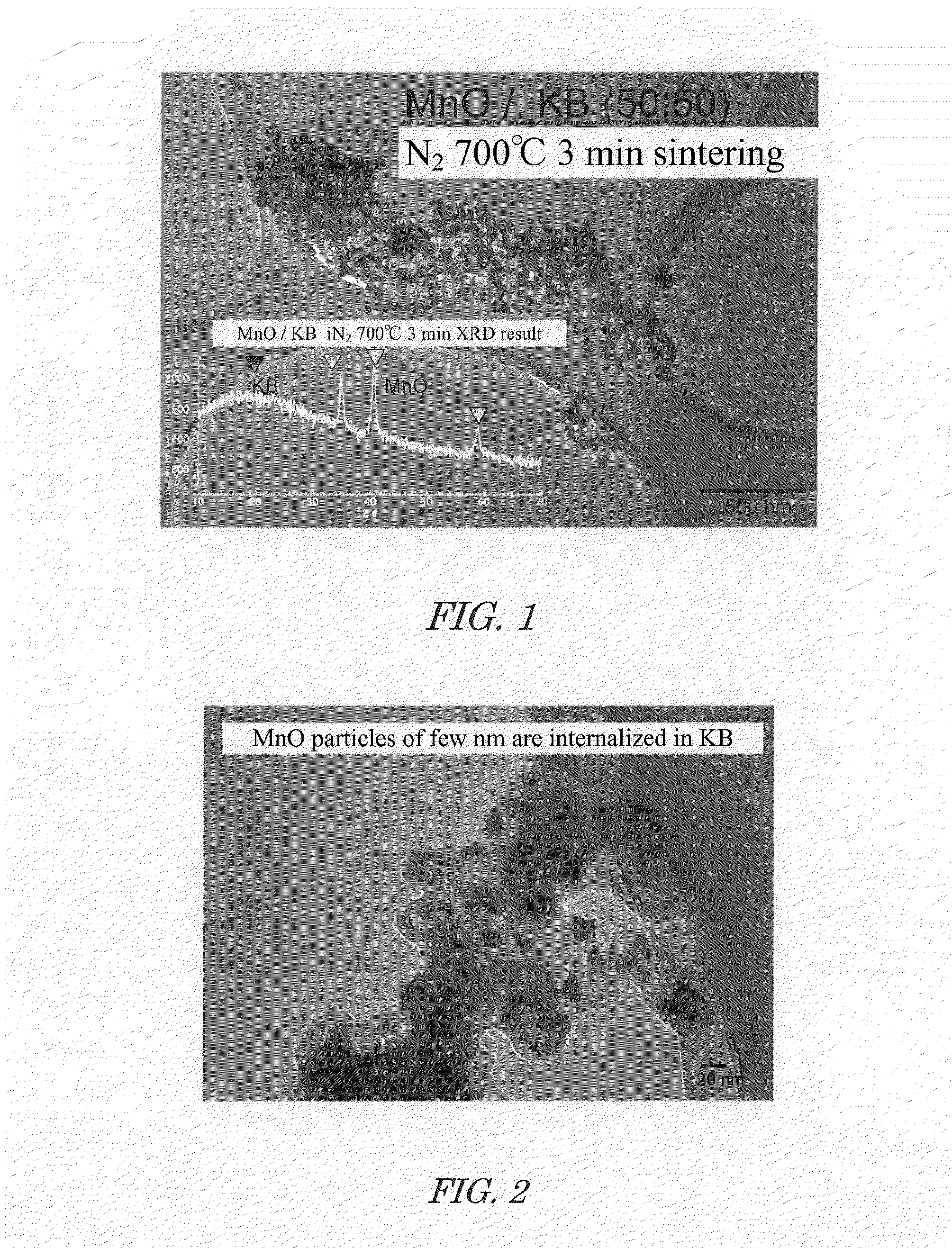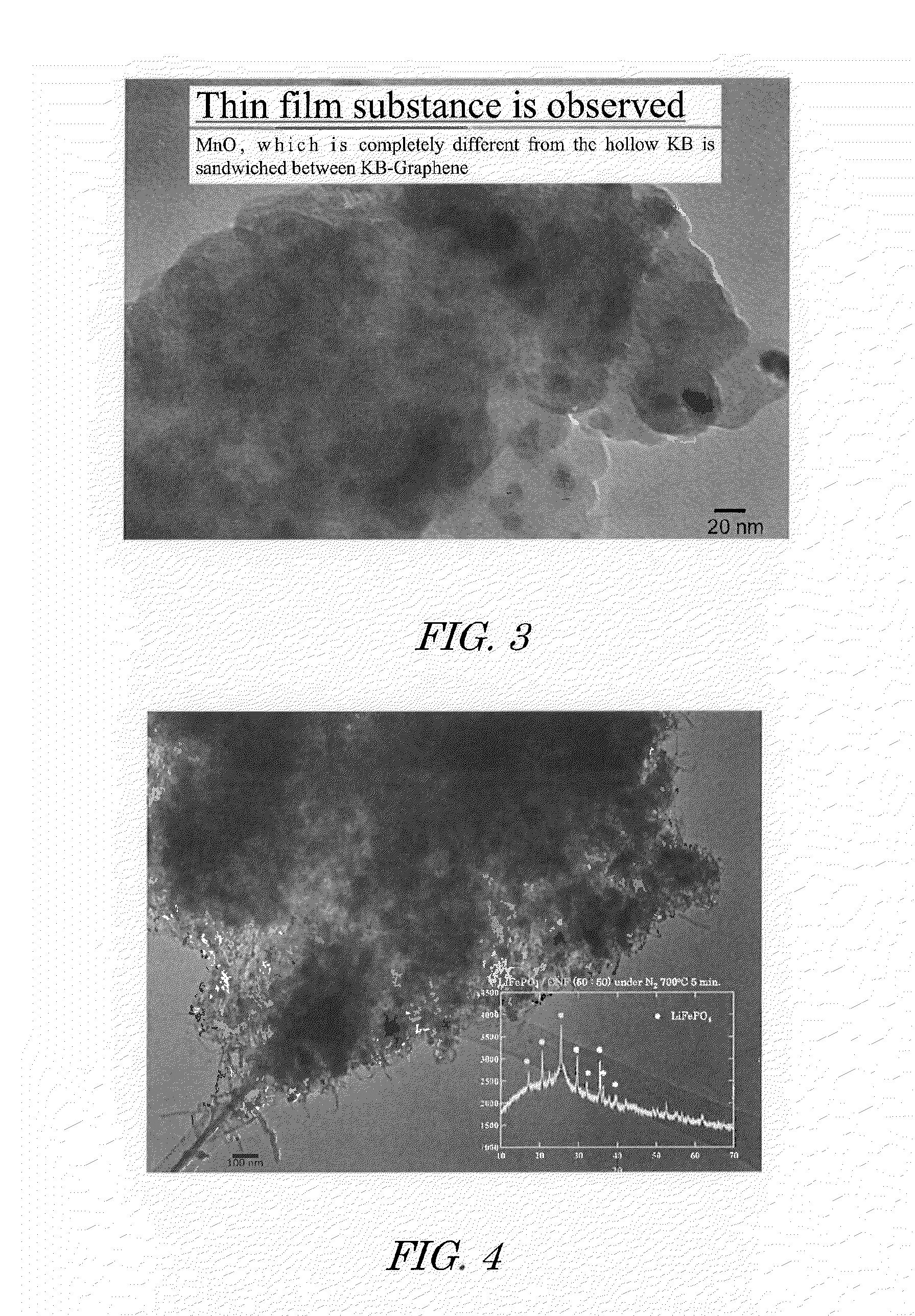Composite of metal oxide nanoparticles and carbon, method of production thereof, electrode and electrochemical element employing said composite
a technology which is applied in the field of composites carbon, can solve the problems of lithium titanate having a low output property and the risk of electrolysis solution decomposition, and achieve good crystallization of metal oxide nanoparticles
- Summary
- Abstract
- Description
- Claims
- Application Information
AI Technical Summary
Benefits of technology
Problems solved by technology
Method used
Image
Examples
example 1
[0058]A mixed solution of 1 mole of manganese acetate, ethanol, and water was prepared. This mixed solution and Ketjen Black (KB) were introduced into a rotary reactor, the inner tube was rotated at a centrifugal force of 66,000 N (kgms−2) for 5 minutes to form a thin film of the reactant on the inner wall of the outer tube, and sheer stress and centrifugal force were applied to the reactant to allow promotion of chemical reaction, yielding KB supporting highly dispersed manganese oxide precursor.
[0059]By drying the obtained KB supporting highly dispersed manganese oxide precursors under vacuum at 80° C. for 17 hours, a composite powder in which highly dispersed manganese oxide precursors are supported on KB was obtained.
[0060]By rapidly heating the obtained composite powder in which highly dispersed manganese oxide precursors are supported on KB under nitrogen atmosphere to 700° C., crystallization of manganese oxide was allowed to progress, and a composite powder in which highly d...
example 2-1
[0064]An aqueous solution of 1.0 mole of phosphoric acid and 1 mole of lithium acetate relative to 1 mole of iron acetate was prepared. Citric acid was employed here as the reaction suppressor. This solution and carbon nanofiber (CNF) were introduced into a rotary reactor, the inner tube was rotated at a centrifugal force of 66,000 N (kgms−2) for 5 minutes to form a thin film of the reactant on the inner wall of the outer tube, and sheer stress and centrifugal force were applied to the reactant to allow promotion of chemical reaction, yielding CNF supporting highly dispersed olivine-type lithium iron phosphate precursor. In this case, the amounts of iron acetate, phosphoric acid, lithium acetate, and CNF to be dissolved in the mixed solvent were set so that the composition of the composite obtained was lithium iron phosphate / CNF at a mass ratio (w / w) of 50 / 50.
[0065]By drying the obtained CNF supporting highly dispersed lithium iron phosphate precursors under vacuum at 80° C. for 17 ...
example 2-2
[0072]A cell was prepared as in Example 2-1 except that lithium iron phosphate / CNF was set to be at a mass ratio (w / w) of 60 / 40. The capacitance of this cell was 71 mAh / g. In addition, the high resolution TEM image of this composite powder is shown in FIG. 12. As seen from this figure, a lithium iron phosphate crystal structure having a thickness of 1 nm or less at 2-5 atomic layers level on a plate of 5-100 nm in diameter is supported on CNF.
PUM
| Property | Measurement | Unit |
|---|---|---|
| diameter | aaaaa | aaaaa |
| thickness | aaaaa | aaaaa |
| thickness | aaaaa | aaaaa |
Abstract
Description
Claims
Application Information
 Login to View More
Login to View More - R&D
- Intellectual Property
- Life Sciences
- Materials
- Tech Scout
- Unparalleled Data Quality
- Higher Quality Content
- 60% Fewer Hallucinations
Browse by: Latest US Patents, China's latest patents, Technical Efficacy Thesaurus, Application Domain, Technology Topic, Popular Technical Reports.
© 2025 PatSnap. All rights reserved.Legal|Privacy policy|Modern Slavery Act Transparency Statement|Sitemap|About US| Contact US: help@patsnap.com



